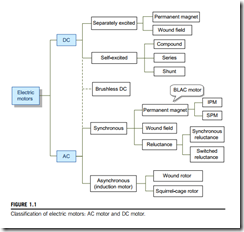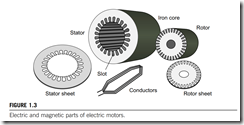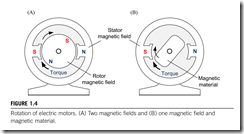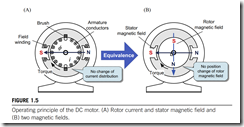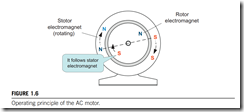A moving object that has either a linear motion or rotary motion is powered by a prime mover. A prime mover is an equipment that produces mechanical power by using thermal power, electricity, hydraulic power, steam, gas, etc. Examples of the prime mover include a gas turbine, an internal combustion engine, and an electric motor. Among these, the electric motors have recently become one of the most important prime movers and their use is increasing rapidly. Nearly 70% of all the electricity used in the current industry is used to produce electric power in the motor driven system [1].
Electric motors can be classified into two different kinds according to the type of the power source used as shown in Fig. 1.1: direct current (DC) motor and alternating current (AC) motor. The recently developed brushless DC motor is hard to be classified as either one of the motors since its configuration is similar to that of a permanent magnet synchronous motor (AC motor), while its electrical characteristics are similar to those of a DC motor.
The first electric motor built was inspired by Michael Faraday’s discovery of electromagnetic induction. In 1831, Michael Faraday and Joseph Henry simultaneously succeeded in laboratory experiments in operating the motor for the first time. Later in 1834, M. Jacobi invented the first practical DC motor. The DC motor is the prototype of all motors from the viewpoint of torque production. In 1888, Nikola Tesla was granted a patent for his invention of AC motors, which include a synchronous motor, a reluctance motor, and an induction motor. By 1895, the three phase power source, distributed stator winding, and the squirrelcage rotor had been developed sequentially. Through these developments, the three phase induction motors were finally made available for commercial use in 1896 [2].
Traditionally among the developed motors, DC motors have been widely used for speed and position control applications because of the ease of their torque control and excellent drive performance. On the other hand, induction motors have been widely used for a general purpose in constant speed applications because of their low cost and rugged construction. Induction motors account for about 80% of all the electricity consumed by motors. Until the early 1970s, major improvement efforts were made mainly toward reducing the cost, size, and weight of the motors. The improvement in magnetic material, insulation material, design and manufacturing technology has played amajor role and made a big progress. As a result, a modern 100 hp motor is the same size as a 7.5 hp motor used in 1897. With the rising cost of oil price due to the oil crisis in 1973, saving the energy costs has become an especially important matter. Since then, major efforts have been made toward improving the efficiency of the motors. Recently, rapidly increasing energy costs and a strong global interest in reducing carbon dioxide emissions have been encouraging industries to pay more attention to high efficiency motors and their drive systems [1].
Along with the improvement of motors, there have been many advances in their drive technology. In the 1960s, the advent of power electronic converters using power semiconductor devices enabled the making of motors with operation characteristics tailored to specific system applications. Moreover, using microcontrollers with high performance digital signal processing features allowed the engineers to apply advanced control techniques to motors, greatly increasing the performance of motor driven systems.
1.1 FUNDAMENTAL OPERATING PRINCIPLE OF ELECTRIC MOTORS
1.1.1 CONFIGURATION OF ELECTRIC MOTORS
An electric motor is composed of two main parts: a stationary part called the stator and a moving part called the rotor as shown in Fig. 1.2. The air gap between the stator and the rotor is needed to allow the rotor to spin, and the length of the air gap can vary depending on the kind of motors.
The stator and the rotor part each has both an electric and a magnetic circuit. The stator and the rotor are constructed with an iron core as shown in Fig. 1.3, through which the magnetic flux created by the winding currents will flow and which plays a role of supporting the conductors of windings. The current carrying conductors inserted into slots in the iron core form the electric circuit. When the current flows in these conductors, a magnetic field is created through the iron core, and the stator and the rotor each becomes an electromagnet.
To obtain a greater magnetic flux for a given current in the conductors, the iron core is usually made up of ferromagnetic material with high magnetic permeability, such as silicon steel. In some cases, the stator or the rotor creates a magnetic flux by using a permanent magnet.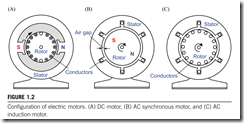
1.1.2 BASIC OPERATING PRINCIPLE OF ELECTRIC MOTORS
All electric motors are understood to be rotating based on the same operating principle. As shown in Fig. 1.4A, there are generally two magnetic fields formed inside the motors. One of them is developed on the stationary stator and the other one on the rotating rotor. These magnetic fields are generated through either energized windings, use of permanent magnets, or induced currents. A force produced by the interaction between these two magnetic fields gives rise to a torque on the rotor and causes the rotor to turn. On the other hand, some motors, such as the reluctance motor, use the interaction between one magnet field and a magnetic material, such as iron, but they cannot produce a large torque (Fig. 1.4B). Most motors in commercial use today including DC, induction, and synchronous motors exploit the force produced through the interaction between two magnetic fields to produce a larger torque
The torque developed in the motor must be produced continuously to function as a motor driving a mechanical load. Two motor types categorized according to the used power source, i.e., DC motor and AC motor, have different ways of achieving a continuous rotation. Now, we will take a closer look at these methods for achieving a continuous rotation.
1.1.2.1 Direct current motor
The simple concept for the rotation of a DC motor is that the rotor rotates by using the force produced on the current carrying conductors placed in the magnetic field created by the stator as shown in Fig. 1.5A. Alternatively, we can consider the operating principle of a DC motor from the viewpoint of two magnetic fields as shown in Fig. 1.4A as follows.
There are two stationary magnetic fields in a DC motor as shown in Fig. 1.5B. One stationary magnetic field is the stator magnetic field produced by magnets or a field winding. The other is the rotor magnetic field produced by the current in the conductors of the rotor. It is important to note that the rotor magnetic field is also stationary despite the rotation of the rotor. This is due to the action of brushes and commutators, by which the current distribution in the rotor conductors is always made the same regardless of the rotor’s rotation as shown in Fig. 1.5A. Thus the rotor magnetic field will not rotate along with the rotor. A consistent interaction between these two stationary magnetic fields produces a torque, which causes the rotor to turn continuously. We will study the DC motor in more detail in Chapter 2
1.1.2.2 Alternating current motor
Unlike DC motors that rotate due to the force between two stationary magnetic fields, AC motors exploit the force between two rotating magnetic fields. In AC motors both the stator magnetic field and the rotor magnetic field rotate, as shown in Fig. 1.6.
As it will be described in more detail in Chapter 3, these two magnetic fields always rotate at the same speed and, thus, are at a standstill relative to each other and maintain a specific angle. As a result, a constant force is produced between them, making the AC motor is to run continually. The operating principle of the AC motor is that the force produced by the interaction between the two rotating magnetic fields causes the rotor to turn
In AC motors, the rotating magnetic field on the stator is created by threephase currents. When a three phase AC power source is applied to the three phase stator windings of the AC motor, the three phase currents flowing in these windings create a rotating magnetic field. We will examine the rotating magnetic field in more detail in Chapter 3.
There are two kinds of AC motors: a synchronous motor and an induction (asynchronous) motor. They generate the rotor magnetic field differently, whereas they generate the stator magnetic field in the same way. In a synchronous motor as depicted in Fig. 1.2B, the magnetic field on the rotor is generated either by a permanent magnet or by a field winding powered by a DC power supply separated from the stator AC power source. In this motor, the rotor magnetic field is stationary relative to the rotor. Hence, to produce a torque, the rotor should rotate at the same speed as the stator rotating magnetic field. This speed is called the synchronous speed. This is why this motor is referred to as the synchronous motor.
On the other hand, in an induction motor as shown in Fig. 1.2C, the rotor magnetic field is generated by the AC power. The AC power used in the rotor excitation is transferred from the stator by electromagnetic induction. Because of this crucial feature, this motor is referred to as the induction motor. In an induction motor, the rotor magnetic field rotates relative to the rotor at some speed. To produce a torque, the stator and the rotor rotating magnetic fields should rotate at the same speed. This requires that the rotor itself rotate at the speed difference between the stator and rotor rotating magnetic fields. More precisely, the rotor rotating magnetic field rotates at the speed difference between the stator rotating magnetic field and the rotor. To use the rotor excitation by electromagnetic induction, the rotor speed should always be less than the synchronous speed. Thus the induction motor is also called the asynchronous motor
Among the motors, DC motors have largely been used for speed and torque control because of their simplicity. Their simplicity comes from the fact that the speed of a DC motor is proportional to the voltage, and its torque is proportional to the current. However, since DC motors require periodic maintenance of the brushes and commutators, the trend has recently moved toward employing maintenance free AC motors as they can offer high performance at a reasonable price
As mentioned earlier, electric motors can operate on the fundamental principle that the torque produced from the interaction between the magnetic fields generated in the stator and the rotor causes the motor to run. Now, we will take a look at the requirements that ensure continuous torque production by the motor
